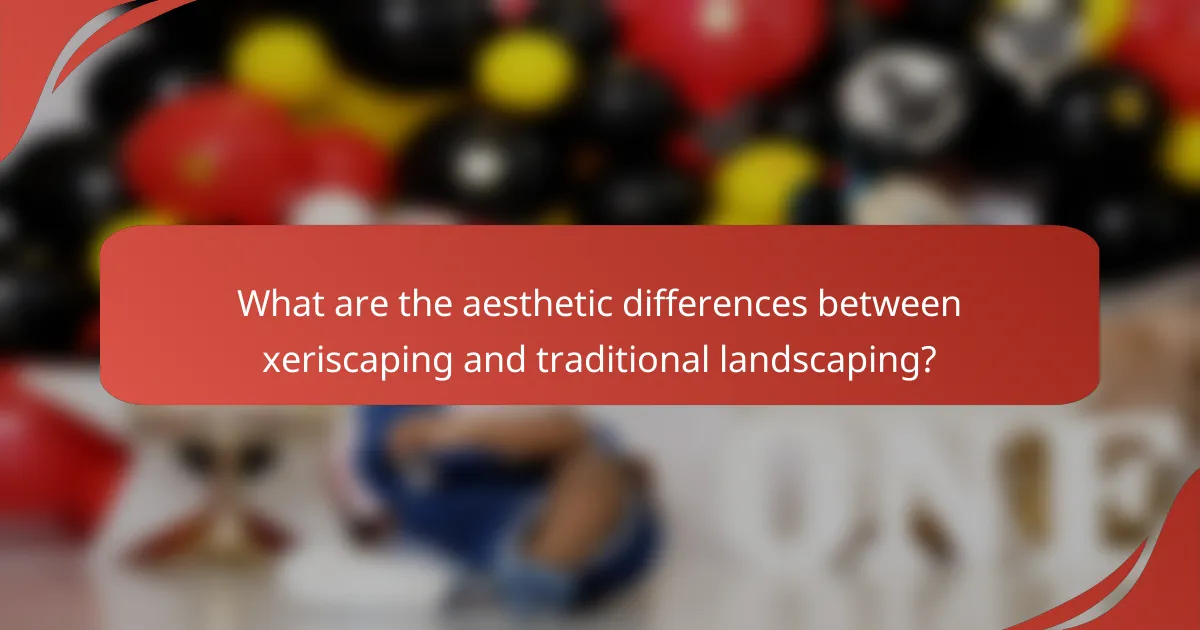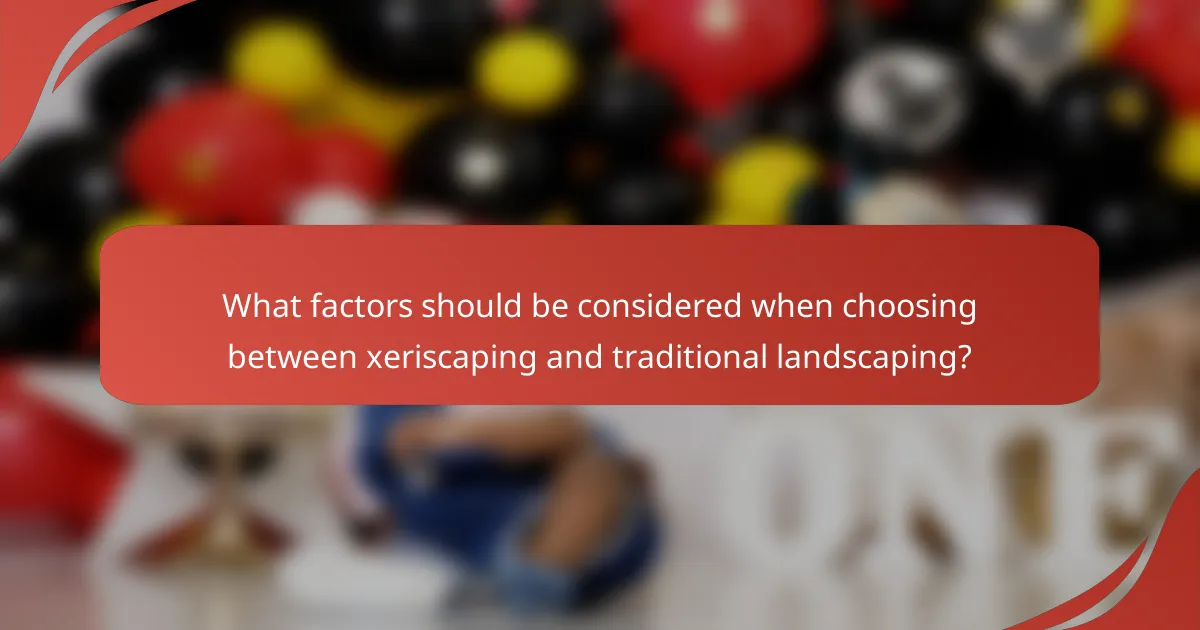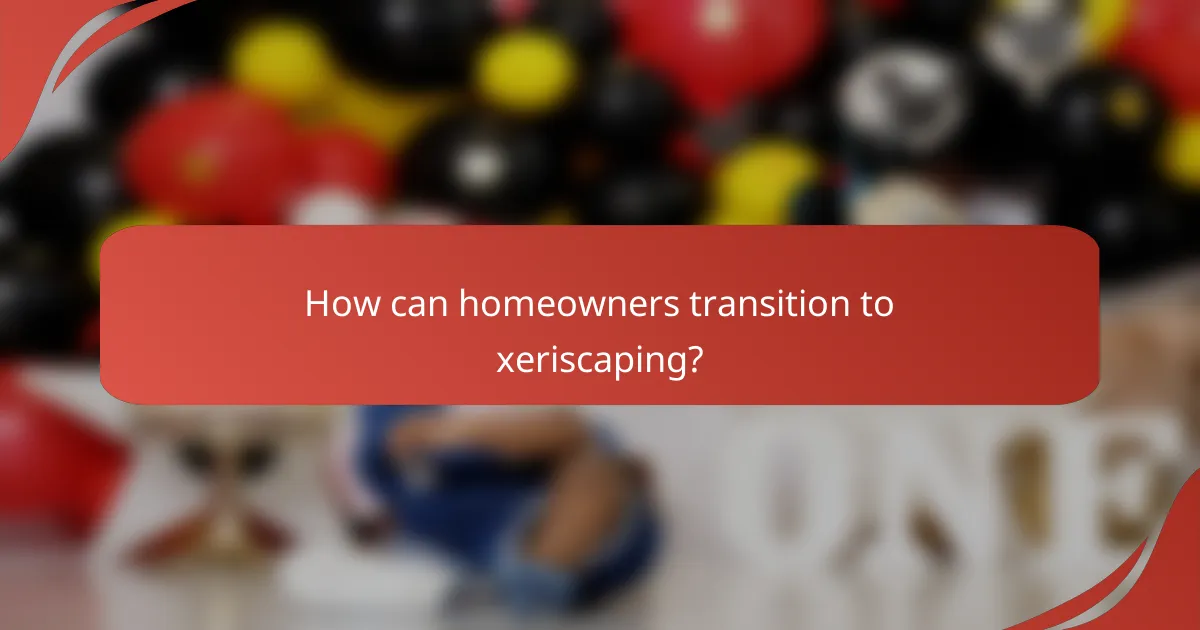When comparing xeriscaping to traditional landscaping, homeowners must consider both the initial investment and long-term benefits. While xeriscaping may require a higher upfront cost, it promotes water efficiency and reduces maintenance, ultimately leading to significant savings and environmental advantages. This eco-friendly approach is particularly beneficial in arid regions, supporting local ecosystems and minimizing resource usage.

What are the cost differences between xeriscaping and traditional landscaping?
Xeriscaping typically has a higher initial investment compared to traditional landscaping, but it offers significant long-term savings. Understanding these cost differences can help homeowners make informed decisions based on their budget and environmental goals.
Xeriscaping initial investment
The initial investment for xeriscaping can vary widely, generally ranging from a few thousand to over ten thousand USD, depending on the size of the area and the types of drought-resistant plants chosen. This upfront cost includes landscaping design, soil preparation, and the installation of efficient irrigation systems.
While the initial costs may seem steep, xeriscaping often requires fewer resources over time, making it a sustainable choice. Homeowners should consider the long-term benefits when evaluating these initial expenses.
Traditional landscaping initial investment
Traditional landscaping usually has a lower initial investment, often ranging from one thousand to several thousand USD, depending on the complexity of the design and the plants selected. This cost typically covers soil preparation, plant installation, and basic irrigation systems.
However, traditional landscaping often requires more maintenance and resources, which can increase costs over time. Homeowners should factor in these potential ongoing expenses when assessing the overall financial commitment.
Long-term savings of xeriscaping
Xeriscaping can lead to significant long-term savings, primarily due to reduced water usage and lower maintenance costs. Homeowners may see water bills decrease by up to fifty percent, especially in arid regions where water conservation is crucial.
Additionally, xeriscaped gardens often require less frequent mowing, pruning, and fertilization, further reducing maintenance costs. This makes xeriscaping an economically viable option for those looking to save money in the long run.
Long-term costs of traditional landscaping
Traditional landscaping can incur higher long-term costs due to increased water usage, regular maintenance, and potential plant replacement. Homeowners may face rising water bills, particularly in dry seasons, as well as ongoing expenses for lawn care services.
Moreover, traditional landscapes often require chemical fertilizers and pesticides, which can add to the overall cost and environmental impact. Understanding these long-term costs is essential for homeowners considering traditional landscaping options.

What are the environmental benefits of xeriscaping?
Xeriscaping offers significant environmental benefits by promoting water efficiency, supporting local ecosystems, and reducing the need for chemical inputs. This landscaping approach focuses on using drought-resistant plants and minimizing water usage, making it an eco-friendly choice for arid regions.
Water conservation in xeriscaping
Xeriscaping is primarily designed to conserve water by selecting plants that require minimal irrigation. By utilizing native and drought-tolerant species, homeowners can reduce their water consumption by up to 50% compared to traditional landscaping methods. This is particularly beneficial in areas facing water scarcity or drought conditions.
Implementing efficient irrigation systems, such as drip irrigation or rainwater harvesting, further enhances water conservation efforts. These systems deliver water directly to the plant roots, minimizing evaporation and runoff.
Impact on local ecosystems
Xeriscaping positively impacts local ecosystems by providing habitats for native wildlife. The use of indigenous plants supports pollinators like bees and butterflies, which are essential for maintaining biodiversity. This approach helps create a balanced ecosystem that can thrive without excessive human intervention.
Additionally, xeriscaped areas can improve soil health and reduce erosion. Native plants often have deeper root systems that stabilize the soil and enhance its nutrient content, benefiting the surrounding environment.
Reduction of chemical use
One of the key benefits of xeriscaping is the significant reduction in the use of fertilizers and pesticides. Drought-resistant plants are typically more resilient to pests and diseases, reducing the need for chemical treatments. This not only lowers costs for homeowners but also minimizes harmful runoff into local waterways.
By opting for organic gardening practices and maintaining healthy soil, xeriscaping promotes a sustainable approach to landscaping. Homeowners can further enhance this benefit by using mulch to suppress weeds and retain moisture, reducing the need for herbicides.

How does maintenance compare between xeriscaping and traditional landscaping?
Xeriscaping generally requires less maintenance than traditional landscaping due to its focus on drought-resistant plants and efficient water use. This can lead to lower long-term costs and less time spent on upkeep, making it an attractive option for many homeowners.
Xeriscaping maintenance requirements
Xeriscaping maintenance primarily involves occasional weeding, pruning, and monitoring plant health. Since xeriscaped areas use native and drought-tolerant plants, they often need less frequent watering, especially in arid climates. Regular mulching can also help suppress weeds and retain soil moisture.
Routine tasks may include checking irrigation systems, especially if drip irrigation is used, and replacing any dead plants. Overall, the maintenance is typically minimal, allowing homeowners to enjoy their landscapes without extensive labor.
Traditional landscaping maintenance needs
Traditional landscaping often demands more frequent maintenance, including regular mowing, watering, fertilizing, and pest control. These tasks can be time-consuming and may require a larger financial investment in equipment and supplies. For instance, lawns may need weekly mowing during the growing season, which can add up over time.
Additionally, traditional landscapes may require seasonal changes, such as planting annual flowers or managing invasive species. Homeowners should be prepared for ongoing costs related to water usage, fertilizers, and potential landscaping services, which can significantly impact overall expenses.

What are the aesthetic differences between xeriscaping and traditional landscaping?
Xeriscaping emphasizes drought-resistant plants and minimal water use, resulting in a unique, often more natural look compared to traditional landscaping, which typically features lush, water-intensive gardens. The aesthetic appeal of each approach varies significantly based on plant selection, layout, and maintenance practices.
Xeriscaping design elements
Xeriscaping incorporates design elements that prioritize water conservation while maintaining visual interest. Common features include native plants, rock gardens, and mulch beds that reduce evaporation. The use of drought-tolerant species creates a landscape that can thrive in arid conditions, often showcasing a variety of textures and colors throughout the seasons.
Additionally, xeriscaping often employs hardscaping elements such as pathways and decorative stones, which can enhance the overall design while minimizing the need for irrigation. This approach not only conserves water but also reduces maintenance costs over time.
Traditional landscaping features
Traditional landscaping typically focuses on lush greenery, colorful flower beds, and well-maintained lawns, requiring significant water resources for upkeep. This style often includes a variety of ornamental plants, shrubs, and trees, creating a vibrant and inviting outdoor space. However, it can lead to higher water bills and increased labor for maintenance.
In traditional landscaping, features like fountains, ponds, and manicured hedges are common, adding to the aesthetic appeal but also increasing water usage. Homeowners should consider the long-term costs associated with maintaining such landscapes, especially in regions prone to drought.

What factors should be considered when choosing between xeriscaping and traditional landscaping?
When deciding between xeriscaping and traditional landscaping, consider factors such as climate, local conditions, personal preferences, and lifestyle. Each approach has distinct benefits and costs that can significantly impact your gardening experience and maintenance efforts.
Climate and local conditions
Climate plays a crucial role in determining the suitability of xeriscaping versus traditional landscaping. Xeriscaping is particularly beneficial in arid or semi-arid regions where water conservation is essential. In contrast, traditional landscaping may thrive in areas with abundant rainfall and diverse plant species.
Local conditions, such as soil type and drainage, also influence your choice. For instance, xeriscaping often utilizes drought-resistant plants that require less water and can adapt to poor soil conditions. Traditional landscaping may need more fertile soil and regular irrigation to maintain lush greenery.
Personal preferences and lifestyle
Your personal preferences and lifestyle significantly affect the choice between xeriscaping and traditional landscaping. If you prefer low-maintenance gardens that require minimal watering, xeriscaping is an excellent option. It allows you to enjoy a beautiful yard without the constant upkeep associated with traditional gardens.
Conversely, if you enjoy gardening as a hobby and appreciate a variety of plants, traditional landscaping may suit you better. This approach often involves regular maintenance tasks such as watering, pruning, and fertilizing, which can be fulfilling for gardening enthusiasts.

What are the common misconceptions about xeriscaping?
Common misconceptions about xeriscaping often lead to misunderstandings about its purpose and benefits. Many people believe it is only suitable for dry climates or that it sacrifices beauty for water conservation.
Xeriscaping is only for arid regions
A prevalent myth is that xeriscaping is exclusively for arid regions. In reality, xeriscaping can be beneficial in various climates, including humid areas, where it can help manage water usage effectively. By selecting appropriate plants and landscaping techniques, homeowners can create a sustainable garden regardless of their local climate.
For instance, in regions with seasonal rainfall, xeriscaping can reduce runoff and promote better water absorption in the soil. This approach not only conserves water but also enhances the resilience of gardens against droughts and heavy rains.
Xeriscaping lacks visual appeal
Another misconception is that xeriscaping is unattractive or barren. On the contrary, xeriscaping can be vibrant and aesthetically pleasing by incorporating a variety of native and drought-resistant plants. These plants often have unique textures, colors, and seasonal blooms that can create a visually stunning landscape.
To enhance visual appeal, consider using hardscaping elements such as stones, pathways, and decorative features. Combining these elements with diverse plant selections can result in a beautiful and functional outdoor space that requires minimal water and maintenance.

How can homeowners transition to xeriscaping?
Homeowners can transition to xeriscaping by gradually replacing traditional landscaping with drought-resistant plants and efficient irrigation systems. This approach not only conserves water but also reduces maintenance costs and enhances the landscape’s resilience to climate changes.
Steps for transitioning to xeriscaping
Begin by assessing your current landscape and identifying areas that require high water usage. Determine which plants can be replaced with drought-tolerant varieties that thrive in your local climate. Consider native plants, as they typically require less water and are better adapted to local soil conditions.
Next, plan your xeriscape layout. Group plants with similar water needs together to optimize irrigation. Incorporate hardscaping elements like gravel paths or stone features to reduce the area needing irrigation and enhance visual appeal.
Finally, implement efficient irrigation practices. Drip irrigation systems are ideal for delivering water directly to plant roots, minimizing waste. Regularly monitor your landscape’s water needs and adjust your watering schedule based on seasonal changes and rainfall patterns.
